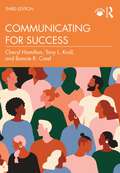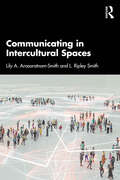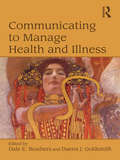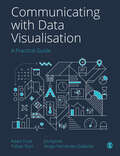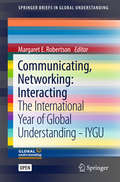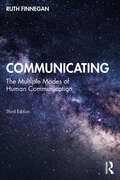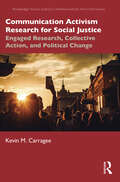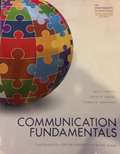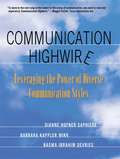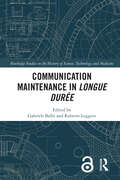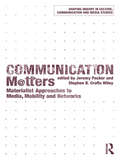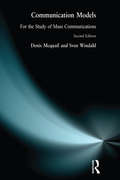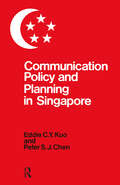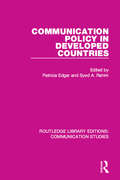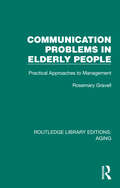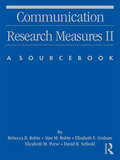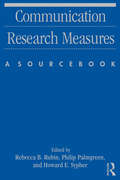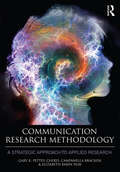- Table View
- List View
Communicating for Success
by Bonnie Creel Cheryl R. Hamilton Tony L. KrollCommunicating for Success, third edition, is a core textbook for Introduction to Communication courses and gives students an overview of the subfields of Communication Studies and how these areas provide practical, fun, and immediate applications to students pursuing a wide variety of career paths, as well as practical instruction in public speaking for success on today’s social media platforms. This fully updated third edition focuses on the key communication competencies recommended by the National Communication Association, including verbal and nonverbal communication, listening, interpersonal communication and conflict resolution, group and organizational communication, public speaking, leadership, and the roles of social media, technology, culture, gender, and ethics in communication. With a vibrant and engaging design, this volume is packed with applied features including practical scenarios and examples, key terms, discussion questions, sample activities, learning objectives, and more. A concentrated focus on the influence of communication on careers in business, education, and healthcare is highlighted in a two-page career spread at the end of each chapter and takes lessons beyond the classroom. New features in this edition include a greater focus on public speaking in the workplace; emphasis on demographic and behavioral factors in audience analysis; and increased discussion of issues of social justice and equity. Online resources for instructors include PowerPoint slides and an Instructor’s Manual with guidance on how to use the book’s activities in both in-person and online courses.
Communicating in Intercultural Spaces
by Lily A. Arasaratnam-Smith L. Ripley SmithCommunicating in Intercultural Spaces is a unique contribution to literature in intercultural communication from two authors who bring distinct socio-cultural voices to this work. Written for readers ranging from advanced undergraduate students to intercultural practitioners, this book offers a new conceptualisation for understanding intercultural communication. Eight propositions frame the concept of intercultural spaces.Grounding the discussion on the framing of intercultural spaces, the authors engage with a range of topics such as perception, language, acculturation, and intercultural competence, couched in original personal narratives from 21 leading intercultural scholars. The narratives and vignettes add vibrant context to the scholars’ works that are cited in this book. The book also delves into the origins of intercultural communication as a discipline and the dark side of communicating across differences. Each chapter ends with a brief dialogue between the authors, followed by questions for stimulating further reflection.Readers should expect to walk away with an understanding of key theories and frameworks in intercultural communication and the tools with which to develop their own intercultural communication competence.
Communicating in the Third Space (Routledge Research in Cultural and Media Studies)
by Gerhard Wagner Karin IkasCommunicating in the Third Space aims to clarify Homi K. Bhabha’s theory of the third space of enunciation by reconstructing its philosophical, sociological, geographical, and political meaning with attention to the special advantages and ambiguities that arise as it is applied in practical--as well as theoretical--contexts. The idea of "third space" conceives the encounter of two distinct and unequal social groups as taking place in a special third space of enunciation where culture is disseminated and displaced from the interacting groups, making way for the invention of a hybrid identity, whereby these two groups conceive themselves to partake in a common identity relating to shared space and common dialogue. The essays collected in Communicating in the Third Space--including a preface by Bhabha himself--brilliantly introduce readers to this exciting topic in Cultural and Post-Colonial theory and offers insightful elaboration and critique of the meaning and relevance of life in the "third space." With a preface by Homi K. Bhabha.
Communicating to Manage Health and Illness
by Dale E. Brashers Daena GoldsmithCommunicating to Manage Health and Illness is a valuable resource for those in the field of health and interpersonal communication, public health, medicine, and related health disciplines. This scholarly edited volume advances the theoretical bases of health communication in two key areas: 1) communication, identity, and relationships; and 2) health care provider patient interaction. Chapters aim to underscore the theory that communication processes are a link between personal, social, cultural, and institutional factors and various facets of health and illness. Contributors to the work are respected scholars from the fields of communication, public health, medicine nursing, psychology, and other areas, and focus on ways in which patient identity is communicated in health-related interactions. This book serves as an excellent reference tool and is a substantial addition to health communication literature.
Communicating with Data Visualisation: A Practical Guide
by Adam Frost Tobias Sturt Jim Kynvin Sergio GallardoHow can you transform a spreadsheet of numbers into a clear, compelling story that your audience will want to pass on? This book is a step-by-step guide (honed through the authors′ Guardian masterclasses, workshops and seminars) to bringing data to life through visualisations, from static charts and maps to interactive infographics and motion graphics. Introducing a four-step framework to creating engaging and innovative visualisations, it helps you to: · Find the human stories in your datasets · Design a visual story that will resonate with your audience · Make a clear, persuasive visual that represents your data truthfully · Refine your work to ensure your visual expresses your story in the best possible way. This book also includes a portfolio of best-practice examples and annotated templates to help you choose the right visual for the right audience, and repurpose your work for different contexts.
Communicating with Data Visualisation: A Practical Guide
by Adam Frost Tobias Sturt Jim Kynvin Sergio GallardoHow can you transform a spreadsheet of numbers into a clear, compelling story that your audience will want to pass on? This book is a step-by-step guide (honed through the authors′ Guardian masterclasses, workshops and seminars) to bringing data to life through visualisations, from static charts and maps to interactive infographics and motion graphics. Introducing a four-step framework to creating engaging and innovative visualisations, it helps you to: · Find the human stories in your datasets · Design a visual story that will resonate with your audience · Make a clear, persuasive visual that represents your data truthfully · Refine your work to ensure your visual expresses your story in the best possible way. This book also includes a portfolio of best-practice examples and annotated templates to help you choose the right visual for the right audience, and repurpose your work for different contexts.
Communicating with the World: Interaction between Chinese and International Media
by Liu LihuaThis book analyses the creation and dissemination of discourse in China while examining how its media and the people interact and communicate with the rest of the world. It explores the interplay between language, meanings, social practices, culture and politics in the processes of discourse generation. The book critically studies intercultural communication and Chinese discourse models at the national, institutional and individual levels and the different modes of interaction between China and the world. With the help of several case studies the book analyses reports from the People’s Daily, interpersonal meaning in promotional videos and advertisements in China, rhetoric in the editorials of China Daily and the representation by international media like The Associated Press and The New York Times to explore differences between Chinese and the Western media reporting the same event. It also looks at the complex models through which the Chinese people—both as individuals and as a collective—communicate with and gain an understanding of the rest of the world. Rich in empirical case studies, this book will be an essential read for scholars and researchers of Chinese Studies, communication studies, media and cultural studies, international relations and political communication.
Communicating, Networking: The International Year of Global Understanding - IYGU (SpringerBriefs in Global Understanding)
by Margaret E. RobertsonThis book illustrates the benefits to be gained from digitally networked communication for health, education and transitioning economies in developing nations (Sierra Leone and Papua New Guinea) and developed nations. Growing powers of e-citizenship can help build sustainable futures. This small volume provides a collection of examples and ideas from which the authors hope will help build a wider resource. Understanding how to link everyday lives with global networks in the digital world in ways that add benefit for the world's people, and the health of the planet, is an ongoing project. IYGU recognises the integral roles of networking and communication systems, as well as interactions between people, near and far, as fundamental for building better futures. The global penetration of digital devices means everyday life, present and future, is inextricably linked with information technologies
Communicating: The Multiple Modes of Human Communication
by Ruth FinneganTreatments of human communication mostly draw on cognitive and word-centred models to present it as predominantly a matter of words. This, Finnegan argues, seriously underestimates the far-reaching multi-modal qualities of human interconnecting and the senses of touch, olfaction, and, above all, audition and vision that we draw on. In an authoritative and readable account, Ruth Finnegan brings together research from linguistic and sensory anthropology, material culture, non-verbal communication, computer-mediated communication, and, strikingly, research on animal communication, such as the remarkable gesture systems of great apes. She draws on her background in classical studies and her long anthropological experience to present illuminating examples from throughout the world, past and present. The result is to uncover an amazing array of sounds, sights, smells, gestures, looks, movements, touches, and material objects used by humans and other animals to interconnect both nearby and across space and time She goes on to first explore the extra-sensory modes of communication now being revealed in the extraordinary "new science" research and then, in an incendiary conclusion, to deny the long-prevailing story of human history by questioning whether orality really came before literacy; whether it was really through "the acquisition of language" that our prehistoric cave painting ancestors made a sudden leap into being "true humans"; and finally, astonishingly, to ask whether human communicating had its first roots not, after all, in verbal language but something else. Not to be missed, this highly original book brings a fresh perspective on, among other things, that central topic of interest today – the dawn of human history – and on what being homo sapiens really means. This revised and updated edition has additional illustrations, updated chapters, and a new concluding chapter. A provocative and controversial account that will stir worldwide debate, this book is an essential transdisciplinary overview for researchers and advanced students in language and communication, anthropology, and cultural studies.
Communication
by Tara Funk Katherine ScraperPeople communicated long ago. People communicate today, too. Read to find out how communication helps people.
Communication Activism Research for Social Justice: Engaged Research, Collective Action, and Political Change (Routledge Social Justice Communication Activism Series)
by Kevin M. CarrageeCommunication scholars have taken seriously the call for engaged scholarship, and this book examines the principles, practices, and outcomes of communication activism research for social justice. Communication activism research differs from other engaged communication scholarship through researchers promoting social justice, intervening collaboratively, and creating or assisting established collective actors that represent marginalized communities. Collective actors examined in this book include Black Lives Matter, the feminist movement, and LGBTQ+ groups. This book provides practical guidance on how to perform communication activism research, offering recommendations for managing its challenges and discussing qualitative and quantitative methods for evaluating research interventions focusing on significant contemporary issues. This book will appeal to scholars who study and teach communication and social justice activism as well as scholars from disciplines such as sociology, and it is ideal as a text in courses on communication and activism, engaged communication scholarship, communication and social movements, and communication research methods.
Communication Against Domination: Ideas of Justice from the Printing Press to Algorithmic Media
by Max HänskaThis book tackles the philosophical challenge of bridging the gap between empirical research into communication and information technology, and normative questions of justice and how we ought to communicate with each other. It brings the question of what justice demands of communication to the center of social science research. Max Hänska undertakes expansive philosophical analysis to locate the proper place of normativity in social science research, a looming subject in light of the sweeping roles of information technologies in our social world today. The book’s first section examines metatheoretical issues to provide a framework for normative analysis, while the second applies this framework to three technological epochs: broadcast communication, the Internet and networked communications, and the increasing integration of artificial intelligence and machine learning technologies into our communication systems. Hänska goes beyond the prevailing frameworks in the field by exploring how we answer normative questions and how our answer can change depending on our social context and the affordances of prevailing communications technologies. This book provides an essential guide for scholars as well as graduate and advanced undergraduate students of research and theory in communication, philosophy, political science, and the social sciences.
Communication Crisis at Kent State: A Case Study (Routledge Library Editions: Communication Studies #15)
by Phillip K. Tompkins Elaine Vanden AndersonOriginally published in 1971. On May 4th, 1970, shots fired by the Ohio National Guard at Kent State University were heard around the world. People were either outraged by the killings or outraged at the students. Instant experts rendered the judgment that it was all a problem of communication. This book tested that hypothesis as it presents the result of an in-depth series of interviews both within and outside the university soon after the tragic event. The book includes a narrative of an initial understanding of the incidents but admits its limit in full information as it outlines the results of the study, which looked at systems and subsystems of information flow. This book adds to the understanding of problems of communication in large organisations and particularly education establishments as well as being a cautionary tale of a specific event.
Communication Fundamentals
by Alberts Nakayama MartínCOURSE DESCRIPTION Competent communication is based on the ability to create and share meaning effectively and appropriately in a variety of contexts. This course provides students with theoretical knowledge and practical experience in communicating interpersonally, across cultures, in groups and teams, and in public spaces. We combine an understanding of the theories and research on communication with the development of practical skills. Since audience adaptation is fundamental to effective communication, an appreciation for the differences among people will be integrated into our studies. Through speeches and a paper, in-class and on-line activities, class discussions and debates, we will explore the ways in which differences shape identities and communication styles, and how to recognize and analyze the range of ways in which people communicate, in an effort to also improve our own skills in communicating with a variety of people. A primary focus in this course is on speaking effectively, using and evaluating qualitative data, and examining human differences.
Communication Highwire: Leveraging The Power Of Diverse Communication Styles
by Barbara Kappler Mikk Basma Ibrahim Devries Dianne Hofner SaphiereNo matter where we live or what we do, we deal with people using a wide variety of communication styles every day. At work, in the marketplace and at home, diverse communication styles present opportunities for growth on the one hand, and misunderstanding on the other. Communication Highwire: Leveraging the Power of Diverse Communication Styles is an important breakthrough for managers, team leaders, community leaders, educators, trainers and facilitators as they work with individuals and teams to overcome frustrations, prevent mistakes and save time and money. World-class intercultural trainers and educators share their strategies, techniques and-most importantly-their tools for taking advantage of diversity in the modern world. Communication Highwire offers the following: twenty-six powerful activities, ready to go with a minimum of prep work; the debut of the Five-Factor Model (Context, Goals, Values, Self-Concept and Communication Style Repertoire), presented in an easy-to-use star chart; and dozens of examples that make concepts real and applicable.
Communication Maintenance in Longue Durée (Routledge Studies in the History of Science, Technology and Medicine)
by Gabriele Balbi Roberto LeggeroThis interdisciplinary volume focuses on the politics, economics, technologies, uses, and cultures of maintenance of different forms of communication over long time or in Longue Durée.Throughout the chapters, contributors from a wide range of fields explore transversal and trans-temporal issues of communication maintenance. Among these are the struggles to keep communication infrastructures functioning, the hidden work of maintenance done by both experts and non-experts such as everyday users, the political significance of maintaining communications (or not maintaining them), and the different habits and significance of maintenance in different times and world regions. The forms of communication covered include broadcasting, telecommunications such as the telegraph and telephone, digital and popular media as computers and mobile phones, mostly forgotten media like pneumatic tubes, transportation infrastructures, maps as used as tools to politically control land, the clock as a medium and a material artifact, and many more.This book will be of interest to students and scholars of communication and media studies, the history of science and technology, general history, geography, maintenance studies, and other related disciplines.The Introduction, Chapter 5 and 8 of this book are freely available as a downloadable Open Access PDF at http://www.taylorfrancis.com under a Creative Commons [Attribution-Non Commercial-No Derivatives (CC-BY-NC-ND)] 4.0 license.
Communication Matters: Materialist Approaches to Media, Mobility and Networks (Shaping Inquiry in Culture, Communication and Media Studies)
by Jeremy Packer Stephen B. Crofts WileyCommunication has often been understood as a realm of immaterial, insubstantial phenomena—images, messages, thoughts, languages, cultures, and ideologies—mediating our embodied experience of the concrete world. Communication Matters challenges this view, assembling leading scholars in the fields of Communication, Rhetoric, and English to focus on the materiality of communication. Building on the work of materialist theorists such as Gilles Deleuze, Michel Foucault, Friedrich Kittler, and Henri Lefebvre, the essays collected here examine the materiality of discourse itself and the constitutive force of communication in the production of the real. Communication Matters presents original work that rethinks communication as material and situates materialist approaches to communication within the broader "materiality turn" emerging in the humanities and social sciences. This collection will be of interest to researchers and postgraduate students in Media, Communication Studies, and Rhetoric. The book includes images of the digital media installations of Francesca Talenti, Professor, Department of Communication Studies, University of North Carolina at Chapel Hill.
Communication Models for the Study of Mass Communications: Socio-cultural Perspectives - Contributions Of Ethnic Groups And Communities (Visita Ser.)
by Denis Mcquail Sven WindahlPresents the main existing models of the mass communications process which have been developed during the last thirty years, providing brief descriptions of the most significant concepts and ideas in the study of mass communication, using graphic and verbal models.
Communication Policy & Planning In Singapore
by Eddie C.Y. Kuo Peter S.J. ChenThis study of communication policy and planning the 1st of its kind in Singapore is an attempt to explore and analyze the following areas: communication systems; communication policy; national level policy planning; institutional level communication planning; and project level communication planning. Following an introductory chapter the chapters of this report sketch the sociodemographic characteristics of Singapore society and the history politics government and economy; describe the component systems of the communication network in Singapore today; present an analysis of the use of major types of mass media by the population broken down by demographic characteristics such as ethnicity age and sex; examine the guiding communication policies on which the present communication systems are built and operated; focuse on the structure of general policymaking and planning at the national level in Singapore; consider communication planning at the institutional level using Radio Television Singapore (RTS) as a case study; discuss project level planning; and make some generalizations on communication policy and planning in Singapore.
Communication Policy in Developed Countries (Routledge Library Editions: Communication Studies)
by PATRICIA EDGAR AND SYED A. RAHIMOriginally published in 1983. This book presents a description and critical analysis of the communication systems and policy at the time in the United States, United Kingdom, Canada, the Federal Republic of Germany, Sweden, Australia and New Zealand. It examines the technological and cultural forces shaping policy and communications development, and begins with a chapter presenting a review of the international context and of the conceptual frameworks suggested by scholars concerned with communication policy. Other chapters highlight the common trends among countries, and analyses the unique nature of policy and communications development in each country based on its cultural foundation. All the contributions reflect a common theme which relates to the two distinct sources from which a nation’s communication policy can be studied - official statements about goals and means, and observable results of communication decisions and practices.
Communication Principles for Data Science (Signals and Communication Technology)
by Changho SuhThis book introduces the basic principles underlying the design and analysis of the digital communication systems that have heralded the information revolution. One major goal of the book is to demonstrate the role of the digital communication principles in a wide variety of data science applications, including community detection, computational biology, speech recognition and machine learning. One defining feature of this book is to make an explicit connection between the communication principles and data science problems, as well as to succinctly deliver the “story” of how the communication principles play a role for trending data science applications. All the key “plots” involved in the story are coherently developed with the help of tightly coupled exercise problem sets, and the associated fundamentals are explored mostly from first principles. Another key feature is that it includes programming implementation of a variety of algorithms inspired by fundamentals, together with a brief tutorial of the used programming tools. The implementation is based on Python and TensorFlow. This book does not follow a traditional book-style organization, but is streamlined via a series of lecture notes that are intimately related, centered around coherent storylines and themes. It serves as a textbook mainly for a junior- or senior-level undergraduate course, yet is also suitable for a first-year graduate course. Readers benefit from having a good background in probability and random processes, and basic familiarity with Python. But the background can be supplemented by almost self-contained materials, as well as by numerous exercise problems intended for elaborating on non-trivial concepts. In addition, Part III for data science applications should provide motivation and insights to students and even professional scientists who are interested in the field.
Communication Problems in Elderly People: Practical Approaches to Management (Routledge Library Editions: Aging)
by Rosemary GravellIn the 1980s work with elderly people was making up an increasing proportion of the workload of speech therapists, due to the overall increase in the elderly population. At the same time all health professionals, such as nurses working in long-stay wards or nursing homes, had many elderly patients or clients who showed communication difficulties due to general problems such as institutionalization, social skill deficits, poor hearing or dementia.
Communication Research Measures II: A Sourcebook (Routledge Communication Series)
by Rebecca B. Rubin Alan M Rubin Elizabeth M. Perse David Seibold Elizabeth E. GrahamExpanding and building on the measures included in the original 1994 volume, Communication Research Measures II: A Sourcebook provides new measures in mass, interpersonal, instructional, and group/organizational communication areas, and highlights work in newer subdisciplines in communication, including intercultural, family, and health. It also includes measures from outside the communication discipline that have been employed in communication research. The measures profiled here are "the best of the best" from the early 1990s through today. They are models for future scale development as well as tools for the trade, and they constitute the main tools that researchers can use for self-administered measurement of people's attitudes, conceptions of themselves, and perceptions of others. The focus is on up-to-date measures and the most recent scales and indexes used to assess communication variables. Providing suggestions for measurement of concepts of interest to researchers; inspiring students to consider research directions not considered previously; and supplying models for scale developers to follow in terms of the work necessary to produce a valid and reliable measurement instrument in the discipline, the authors of this key resource have developed a significant contribution toward improving measurement and providing measures for better science.
Communication Research Measures: A Sourcebook (Routledge Communication Series)
by Rebecca B. Rubin Howard E. Sypher Philip PalmgreenThe development of communication as a discipline has resulted in an explosion of scales tapping various aspects of interpersonal, mass, organizational, and instructional communication. This sourcebook brings together scales that measure a variety of important communication constructs. The scales presented are drawn from areas of interpersonal, mass, organizational, and instructional communication--areas in which the use of formal, quantitative scales is particularly well developed. Communication Research Measures reflects the recent important emphasis on developing and improving the measurement base of the communication discipline. It results in an equal amount of labor saved on the part of the scholars, students, and practitioners who find this book useful, and it contributes in a significant way to research efforts.Originally published by Guilford Press in 1994, now available from Routledge.
Communication Research Methodology: A Strategic Approach to Applied Research
by Cheryl Campanella Bracken Elizabeth B. Pask Gary PetteyThis introduction to communication research methods takes the student from the conceptual beginnings of a research project through the design and analysis. Emphasizing the correct questions to ask and how to approach the answers, authors Gary Petty, Cheryl Campanella Bracken, and Elizabeth Babin approach social science methods as a language to be learned, requiring multiple sessions and reinforcement through practice. They explain the basics of conducting communication research, facilitating students’ understanding of the operation and roles of research so that they can better critique and consume the materials in their classes and in the media. The book takes an applied methods approach, introducing students to the conceptual elements of communication science and then presenting these elements in a single study throughout the text, articulating the similarities and differences of individual methods along the way. The study is presented as a communication campaign, involving multiple methodologies. The approach highlights how one method can build upon another and emphasizes the fact that, given the nature of methodology, no single study can give complete answers to our research questions. Unique features of the text: It introduces students to research methods through a conceptual approach, and the authors demonstrate that the statistics are a tool of the concepts. It employs an accessible approach and casual voice to personalize the experience for the readers, leading them through the various stages and steps. The presentation of a communication campaign demonstrates each method discussed in the text. This campaign includes goals and objectives that will accompany the chapters, demonstrates each individual methodology, and includes research questions related to the communication campaign. The tools gained herein will enable students to review, use, understand, and critique research, including the various aspects of appropriateness, sophistication and utility of research they encounter.
